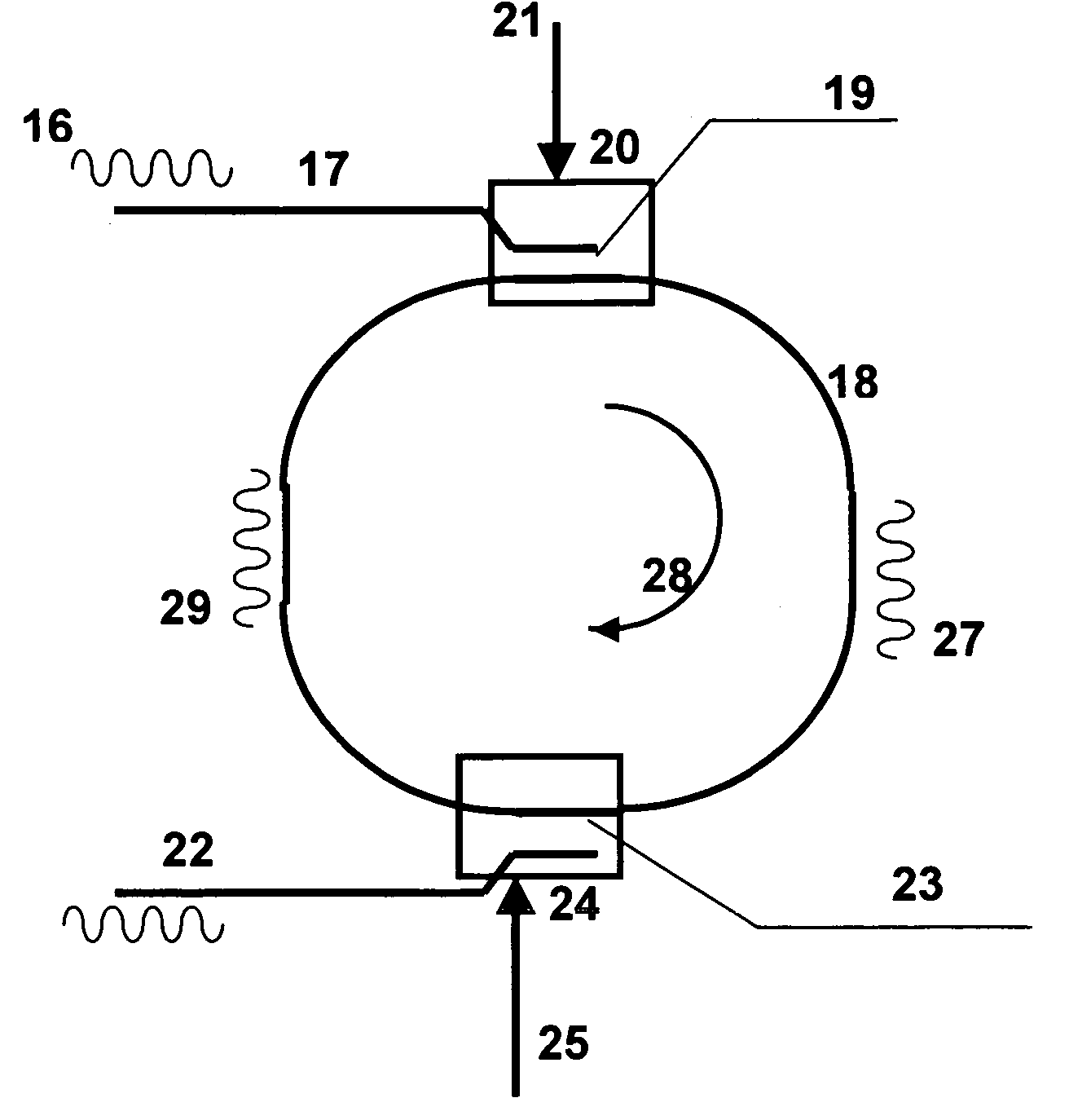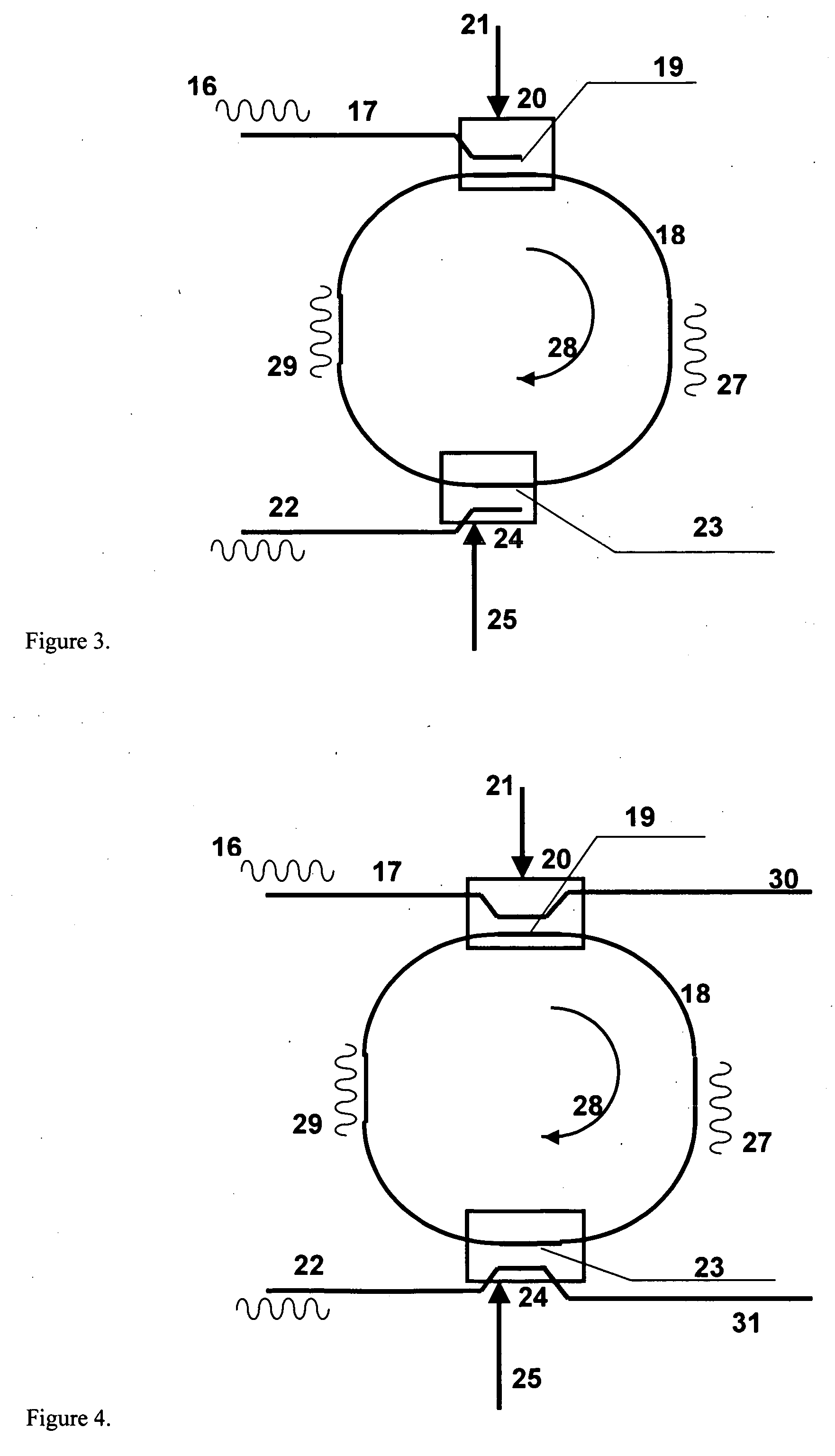Integrated loop resonator with adjustable couplings and methods of using the same
a loop resonator and coupling technology, applied in the field of integrated optical devices, can solve the problems of difficult to ensure the matching of the two coupling gaps/lengths on the two sides of the resonator cavity, the inability to easily tune the coupling coefficient, and the inability to achieve the finesse and the extinction ratio of the resonator
- Summary
- Abstract
- Description
- Claims
- Application Information
AI Technical Summary
Benefits of technology
Problems solved by technology
Method used
Image
Examples
example 1
[0075] An Optical Frequency Comb Generator (OFCG) can be realized in one embodiment of the invention. OFCG consists of a central optical frequency carrier having a set of equally spaced sidebands on either side. The sidebands must be equally spaced if the optical frequency comb is to be phase coherent. The spacing between the sidebands is determined by the frequency of the RF or microwave signal that modulates the optical carrier.
[0076] The phase modulation sidebands must be resonant with the optical cavity modes, hence the term resonant electro-optic modulation, and this condition is met if the modulation frequency is equal to an integer multiple of the optical cavity free spectral range (FSR). Therefore the modulation frequency is in the microwave domain, and the highest practical modulation frequency (10 GHz to 30 GHz) is used because one wishes to achieve the largest OFCG span with the least number of sidebands to reduce the noise. The intensity of the sidebands is determined b...
example 2
[0079] The improvement in the selective diffusion of Er ions has resulted in new integrated devices based on optical amplification. A great deal of effort has been made in realizing optically pumped Er-doped LiNbO lasers, see for example “Advanced Ti:Er:LiNbO3 Waveguide Lasers”, by C. Becker et al. in IEEE J. Selected Topics Quantum Electron., vol. 6, No.1 pp. 101-113, September 2000. Incorporation of a gain element in the resonant loop 18 of the disclosed integrated device allows creating of an efficient narrowband laser with adjustable characteristics. A two-coupler-type Er-doped-fiber ring resonator can compensates for the round-trip optical loss by optical amplification thereby attaining a high finesse. Their performance can be flexibly tailored and the quality factor is adjustable by the tuning of couplings 19 and 23 along with the trimming of the gain of the optical amplifier.
[0080]FIG. 14 depicts the basic scheme for laser beam generation using the loop resonator integrated ...
example 3
[0082] Efficient high-speed electro-optic amplitude modulators can be realized using the disclosed invention. External modulators have proved more challenging with respect to power efficiency and high frequency. Currently, the most efficient modulators demonstrated in the laboratory are of the traveling wave type, and require half-wave voltages (Vpi) in excess of several volts while generally limited to frequencies about 50 GHz. The use of ring resonators as modulators can have substantial, orders of magnitude, improvement in efficiency and result in significant impact on the-technology of optical information generation and transfer, in commercial and specialized government systems.
[0083] Proposed invention enables further improvement of the voltage efficiency of the external modulation while extending the frequency of modulation to above 100 GHz, in a small device. Thus extinction ratio and Vpi, can be adjusted by tuning of resonator couplers ratios K1 and K2 along with phase-shif...
PUM
 Login to View More
Login to View More Abstract
Description
Claims
Application Information
 Login to View More
Login to View More - R&D
- Intellectual Property
- Life Sciences
- Materials
- Tech Scout
- Unparalleled Data Quality
- Higher Quality Content
- 60% Fewer Hallucinations
Browse by: Latest US Patents, China's latest patents, Technical Efficacy Thesaurus, Application Domain, Technology Topic, Popular Technical Reports.
© 2025 PatSnap. All rights reserved.Legal|Privacy policy|Modern Slavery Act Transparency Statement|Sitemap|About US| Contact US: help@patsnap.com



